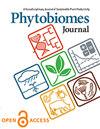Tare soil alters the composition of the developing the potato rhizosphere microbiome
IF 3.3
3区 生物学
Q2 MICROBIOLOGY
引用次数: 0
Abstract
Understanding the factors influencing microbial community composition in the rhizosphere is an important step towards managing the microbiomes of globally important crops like potato (Solanum tuberosum). Potato is vegetatively propagated and seed tubers are planted with tare soil, or soil adhering to the tuber surface, from their field of origin. Bulk soil is known to influence rhizosphere microbiome composition, but whether tare soil additionally contributes to compositional variation is not known. We tested this hypothesis in a greenhouse experiment where tare soil was removed (or remained intact for controls) prior to planting in either soil from a potato field or soil from a previously uncultivated area next the potato field. We used ITS and 16S metabarcoding to characterize the fungal and bacterial rhizosphere communities of plants grown from the experimental seed tubers. We found that tare soil influenced rhizosphere microbial composition, more strongly for fungi than bacteria. As expected, bulk soil origin explained the greatest amount of variation in the rhizosphere microbiome overall, but we found no evidence that the impact of tare soil on microbial community composition differed between bulk soil origins. The magnitude of the tare soil effect did, however, depend in part on seed tuber origin. Our findings reveal that tare soil explains a significant, though modest, amount of variation in rhizosphere composition, and sets the stage for future work addressing functional consequences for plant health and productivity.剥皮土壤改变了马铃薯根际微生物群的组成
了解影响根际微生物群落组成的因素是管理马铃薯(Solanum tuberosum)等全球重要作物微生物群落的重要一步。马铃薯是无性繁殖的,种子块茎是在原产地的皮土或粘在块茎表面的土壤上种植的。已知块状土壤会影响根际微生物组的组成,但皮状土壤是否也会导致组成变化尚不清楚。我们在温室实验中验证了这一假设,在种植之前,在马铃薯田的土壤或马铃薯田旁边以前未开垦地区的土壤中去除皮土(或保持原状作为对照)。利用ITS和16S元条形码技术对实验种块茎生长的植物根际真菌和细菌群落进行了表征。我们发现,土壤对根际微生物组成的影响,真菌比细菌更强烈。正如预期的那样,大块土壤来源解释了根际微生物群落总体上最大的变化,但我们没有发现证据表明皮土对微生物群落组成的影响在大块土壤来源之间存在差异。然而,皮土效应的大小确实在一定程度上取决于种子块茎的来源。我们的研究结果表明,皮质土壤解释了根际组成的显著(尽管适度)变化,并为未来解决植物健康和生产力的功能后果的工作奠定了基础。
本文章由计算机程序翻译,如有差异,请以英文原文为准。
求助全文
约1分钟内获得全文
求助全文

 求助内容:
求助内容: 应助结果提醒方式:
应助结果提醒方式:


